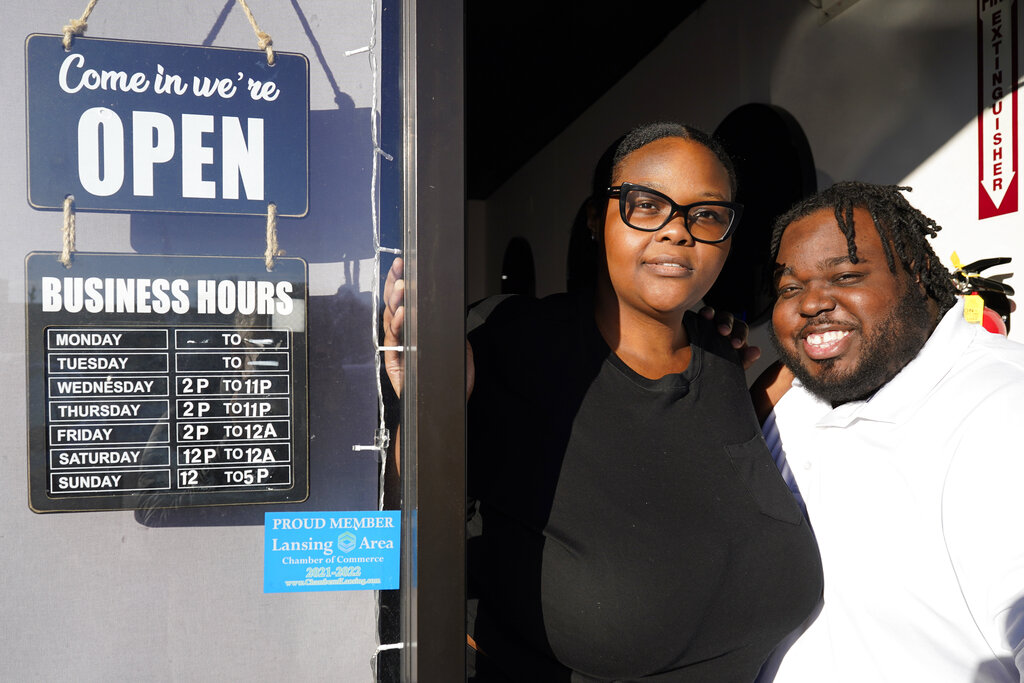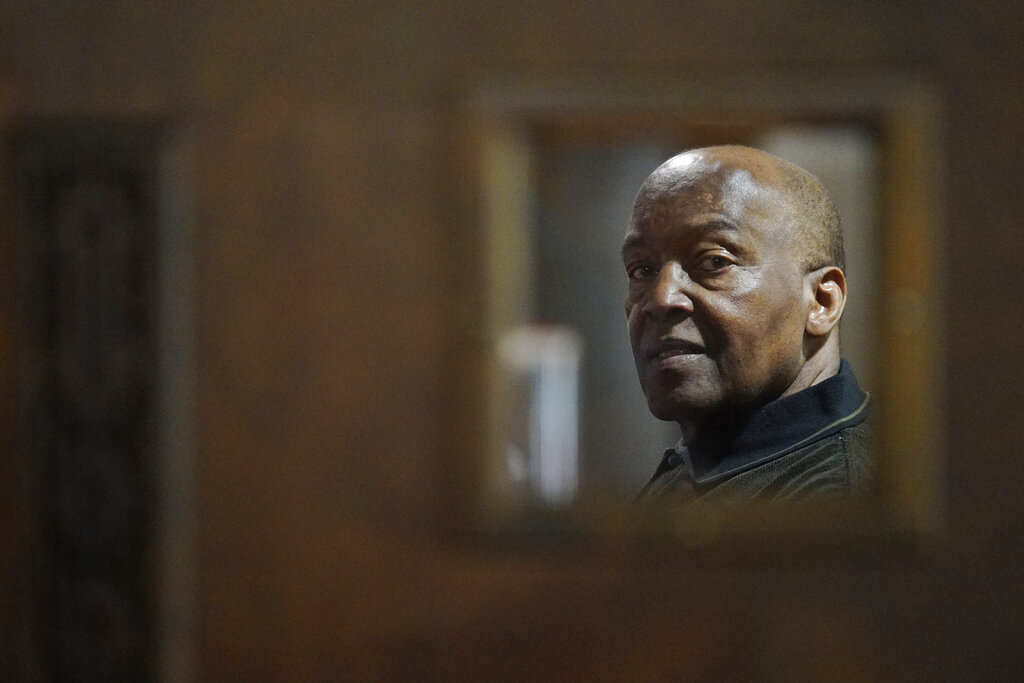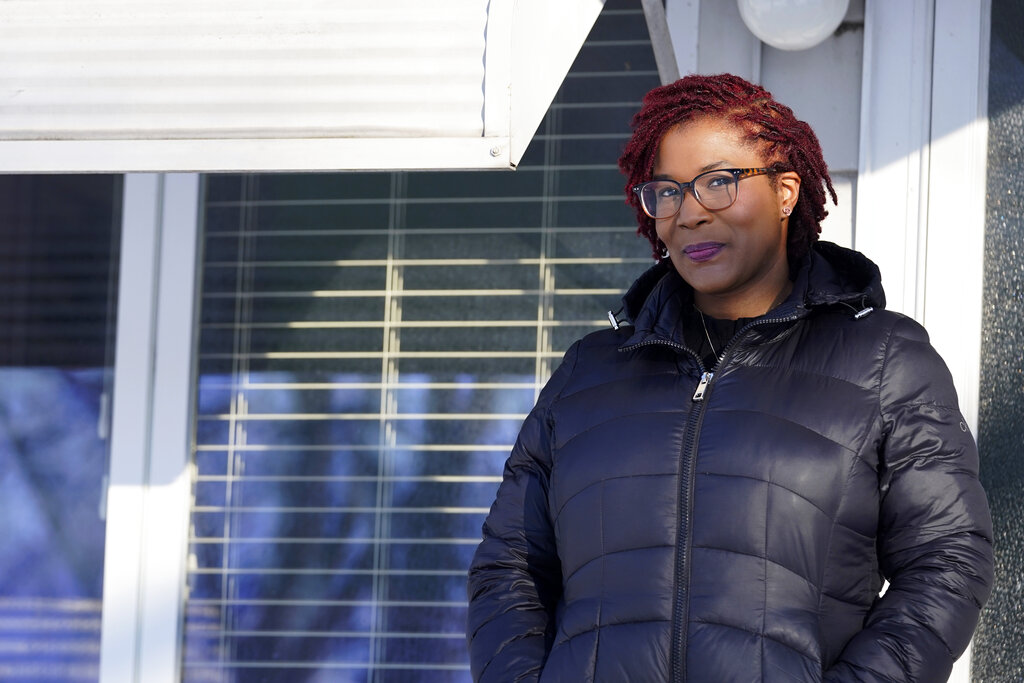Census: Black population grows in suburbs, shrinks in cities

Judy Ware poses for a photo outside of her restaurant in Chicago, Thursday, Jan. 20, 2022. Judy Ware is preparing to resume table service at the Ranch after struggling through the coronavirus pandemic. A fire set during unrest following George Floyd’s killing in Minneapolis destroyed the restaurant’s interior, and takeout-only couldn’t sustain the business, which has been operating for more than 50 years. (AP Photo/Nam Y. Huh)
CHICAGO (AP) — A longtime area staple with its wagon wheel décor and “Roy Rogers ribeye,” The Ranch Steak House is fighting to reopen as one of the last sit-down restaurants in the once-flourishing Black Chicago neighborhood of Roseland.
About 13 miles away near Indiana, Christopher Cain and wife Deja Cousins-Cain sought a new market for their wine bar that promises “Good Vibes Only,” settling on the suburb of Lansing, where growth has included a steady increase in Black residents.
The two enclaves of roughly 30,000 people reflect how Black migration patterns in the 21st century are changing the makeup of metropolitan areas nationwide. For decades, Black residents have been leaving some of the nation’s largest cities while suburbs have seen an increase in their Black populations. Those two trends have now spread to even more areas of the country, according to the 2020 U.S. census.
The patterns echo the “white flight” that upended urban landscapes in the 20th century. Like those who left cities before them, Black residents often move because of worries about crime and a desire for reputable schools, affordable housing and amenities. But there are key differences: Leaving Black city neighborhoods that are starved for investment is often more of a necessity than a choice, and those who do settle into new suburban lives often find racial inequities there, too.
From 1990 to 2000, 13 of the United States’ biggest cities lost Black residents. By 2020, it was 23. According to the census, roughly 54% of Black residents within the 100 biggest American metro areas were suburbanites in 2020, up from 43% two decades ago, according to Bill Frey of the Brookings Institution.
While New York, Los Angeles and Philadelphia all lost Black residents from 2010 to 2020, the change was especially notable in Chicago, which gained population but lost 85,000 Black people, the highest number after Detroit, according to the 2020 census. Those numbers could vary slightly, as the Census Bureau reported last week that 3.3% of the Black population was undercounted in the 2020 census, a rate higher than in 2010.
The official count found that a section of Roseland measuring less than 1 square mile lost 1,600 Black residents. Now, the area near where former President Barack Obama was a community organizer — located about 20 minutes south of downtown — doesn’t even have a grocery store. That makes Judy Ware, who bought the Ranch restaurant in 2018, more determined to hang on.
“We take pride in trying to keep this institution in the neighborhood,” she said. “It’s needed.”
For others, though, the suburbs offer a fresh choice.
Cousins-Cain and her husband surprised themselves in choosing Lansing, which wasn’t always friendly to Black people.
Settled by Dutch and German immigrants, the city has seen a roughly 50% increase in its Black residents, who now represent almost half the population. Lansing recently elected its first Black trustee.
“It just feels like we are finally getting an opportunity to bring something to the table and bring something to the conversation,” Cousins-Cain said.

The trends are nuanced. Part of the explanation is that Black residents are continuing to move to Southern cities in a reversal of the Great Migration, a movement that began in the 1910s and resulted in millions leaving the South for northern cities to escape discrimination. But more recently, some of the starkest changes are happening within metro areas as suburbs of major cities see Black population growth.
Black residents, who represented roughly 40% of Chicago’s population in 1980, now make up less than 30%. Their presence increased, meanwhile, in dozens of Chicago suburbs from 2010 to 2020.
Chicago residents and demographers offer no shortage of reasons for the urban exodus:
— The decline of the steel industry and blue-collar jobs starting in the 1970s. — The war on drugs. — The dismantling of public housing in the 2000s that displaced thousands of Black residents. — School closures in 2014 that disproportionately affected Black and Latino children.
“It’s really hard to point to one specific thing,” said Dan Cooper, director of research with Chicago’s Metropolitan Planning Council. “And when you look at the confluence of factors, Black folks haven’t been centered in policy or they are centered in wrong ways.”
Chicago, long a segregated city, continues to report disparate outcomes by race when it comes to home ownership, income, transportation access and more. In Roseland, residents note persistent crime, delayed city services and a train line that ends at Roseland’s northern edge. Worries persist about population loss diluting Black political power as drafts of a political remapping show fewer majority-Black wards.
Many said those issues forced them to leave.
Truck driver Chris Calhoun, 32, sought more peace in suburban South Holland in 2014.
The deciding factor for him, he said, was, “Where can I live where my kids can go outside and ride their bikes, or we can take a walk around the block as a family without looking over my shoulder?”
Crystal Fenn left in 2015 for law school in suburban Atlanta, where she’s now an attorney.
“If you could do anything better for yourself, why would you want to be there?” she said. “The lack of economic dollars, it’s almost like the city doesn’t care about Roseland anymore.”
Once a Dutch enclave, Roseland was annexed into Chicago in 1892. Within decades, there was an influx of Black families.
Marc Pullins, 56, recalls four nearby grocery stores and has fond memories of Kohn Elementary School.
“Half the neighborhood went to that school,” said Pullins, a current resident and activist. “They’re all gone.”
Kohn is located within the section of Roseland that lost more than 1,600 Black residents. The school sits vacant, a green “For Sale” sign out front. It is among the roughly 55 schools targeted by former Mayor Rahm Emanuel in the nation’s largest mass school closure.
Nearby homes and businesses, including a candy shop, are shuttered. The vacancies extend down a once-thriving business corridor that Preservation Chicago has deemed among Chicago’s “most endangered places.”
Kisha Pleasant, 41, bought her first home in Roseland, but violence and dwindling amenities pushed her out.
“I can’t retire in this area,” she said. “I want to come outside, and I don’t want to be scared that somebody will be shooting at me.”
Last year, she moved to Lansing.

Sameerah and Jerrell Miller moved with their daughter to a leafy Lansing street six years ago after living in Chicago and neighboring Oak Park.
They bought a home near a top school for less than what they would have paid in Chicago. Lansing’s median home price is about $195,000, less than half the city’s median.
“Lansing, to this day, still has kids outside in the summertime playing,” said Jerrell Miller. “You don’t really get that in the city without worry.”
The growing Black population prompted Micaela Smith, who moved to Lansing in 2002, to seek office. She became the suburb’s first Black trustee last year, after a challenging campaign in the predominantly white suburb.
“I had to do more persuasion to convince the voters,” Smith said.
Activists say Lansing has had its fair share of issues involving race. In 2017, a Black teenager was held down and threatened by a white off-duty police officer, a confrontation that led the city to enter a memorandum of understanding with activists and the U.S. Department of Justice.
Pastor David Bigsby of In The Upper Room Ministries recently held a community call about disproportionate traffic stops, noting a major thoroughfare largely divides Black and white residents.
“It’s still segregated in town,” he said.
Still, the 76-year-old, who moved into the parsonage six years ago, has about 250 congregants now, an increase of about 20%.
Lansing is also seeing a boost in Black-owned businesses. Cain and Cousins-Cain opened their chic S.L. Wine Bar last year, with R&B and jazz setting the mood. Support, particularly from Black customers, has been strong.
“We want our own version of ‘Cheers,’” Cousins said.

Roseland residents who remain take pride in Obama’s work there, and say they’ve seen signs of a turnaround.
Chicago officials recently launched a $750 million program to improve neglected neighborhoods, including Roseland, and have detailed plans for a train line extension. The Greater Roseland Chamber of Commerce hopes a community hospital will grow into a medical district.
Judy Ware is preparing to resume table service at the Ranch after struggling through the coronavirus pandemic. A fire set during unrest following George Floyd’s killing in Minneapolis destroyed the restaurant’s interior, and takeout-only couldn’t sustain the business, which has been operating for more than 50 years.
After renaming it Ware Ranch Steak House and installing new flooring and orange booths, Ware is feeling optimistic as she prepares to reopen this month.
“If we can weather the storm, I think we’ll come out good on the other side,” she said. “There is a lot of stuff waiting to happen in Roseland.”
Associated Press writer Mike Schneider in Orlando, Florida, contributed to this report.














